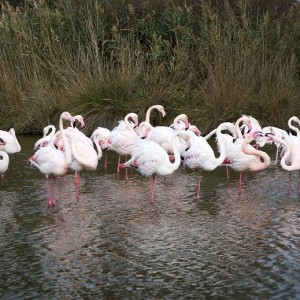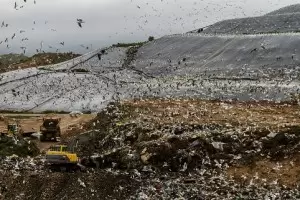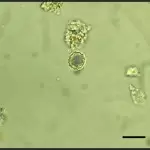
Humans have invented a variety of instruments to monitor the health of ecosystems. For example, to examine water quality in a wetland, an environmental scientist may use a sensor to measure dissolved oxygen in the water or perform chemical assays in the lab to examine heavy metals in the soil. However, in some cases we can examine change in the habitat without instruments because studying the presence and behavior of birds can inform us about changing ecosystems.
Any living organism that is used in such a manner to measure environmental conditions is called an indicator species. Perhaps the best known example is the proverbial “canary in a coal mine.” Since canaries are very susceptible to poisonous gases like carbon monoxide and methane and are affected by it before humans, miners would take canaries into the coal mines when they went to work. If the birds began to show signs of poisoning, it would give miners a chance to put on a mask or escape from the mines before they too succumbed to carbon monoxide poisoning. The use of birds to monitor environmental conditions continues because birds can tells us a suite of useful information about the environment.
What Makes a Good Indicator?
When it comes to usefulness as an indicator, all species are not created equal and a few criteria are required for a species to be valuable in this regard. Firstly, it should be sensitive to changes in the environment in order to serve as an early warning.1 A species that is extraordinarily resilient and not dramatically impacted by environmental changes would offer little information about what is happening in the environment. Additionally, the species needs to respond to changes in a predictable manner. If it responds erratically to change, this would make it hard to interpret the underlying environmental causes of the changes that are observed. Lastly, it should be easy to compile and interpret data on the species to inform policy decisions. Species that are very rare would make poor indicator species because it would be hard to find and study enough of them to draw any meaningful conclusions. Similarly, it would be difficult to gather data on species that have very cryptic life histories or that are in general poorly understood, making them less than ideal candidates for indicator species. With this criteria established, we can explore the different kinds of ecosystem changes that birds can tell us about.
Habitat Quality
One of the most useful things that birds can indicate is overall habitat quality. When birds are dependent on the habitat functioning in specific ways, the population trends of birds can tell us about how well the ecosystem functions. For example, numbers of wading birds nesting in the Everglades are dependent on prey availability. The construction of canals and levees to alter the flow of water in the Everglades in the 1950s severely degraded the ecosystem. This led to less prey availability, which caused massive declines in the annual number of wading birds nesting in the Everglades.2 These declines began before anyone realized that significant damage had been done to the Everglades ecosystem by human activities and wading birds responded well before any other animals. The sensitivity of these birds to proper ecosystem functioning makes them valuable indicators of habitat quality.
In some cases, it is not just the numbers of birds present, but the assemblage of bird species in an area that can indicate habitat quality. A study in the Central Appalachian Mountains showed that when forest habitats became degraded, the types of birds present changed in a predictable fashion.3 Birds were classified into categories based on behavioral and physiological response guilds and a Bird Community Index Score (BCI) was calculated based on the types of birds present. As habitats shifted from undisturbed to degraded, there was a corresponding shift from specialist to generalist species because disturbed habitats could not support very specialized species. Examples of this included shifts from bark probers to omnivores and from canopy nesters to open ground nesters. The study showed that calculating the BCI in a particular habitat was a good indicator of its quality.
Similarly, the presence or absence of very specialized species can indicate habitat quality. For example, the red-cockaded woodpecker has very specific nesting requirements. They require living pine trees of large diameter, typically more than 80 years old, to excavate nest cavities in pine trees.4 In newly planted forests where trees are of smaller diameters, the birds will not nest. Furthermore, they abandon trees when understory plants reach the height of the nest cavity. The suppression of fire causes large growths in the understory, making the habitat unsuitable for nesting. Proper ecosystem functioning in these pine forests requires periodic burning of understory growth. Because these birds have such specific nesting requirements which mandate that the habitat be well-functioning, the numbers of red-cockaded woodpeckers in pine forests can be effective indicators of habitat quality.
Since bird numbers can reflect the quality of the habitat, they can also be used to measure the effectiveness of habitat restoration. This principle has been employed in restoration efforts for the Florida Everglades.5 Alteration of water flow led to concentrations of water in large ponds, which favored birds like egrets that hunt by sight in deep waters. However, birds like ibises and storks that use tactile feeding and relied on concentrated prey in shallow areas suffered. Because a goal of Everglades restoration is to restore widespread water flow, which would create more areas of shallow water, the ratio of storks and ibises to egrets is one metric that can be used to gauge the success of restoration efforts.
Another indicator of restoration is the frequency of large nesting events by white ibises, which was a defining characteristic of the Everglades prior to drainage. The return of these nesting events would indicate that the ecosystem was functioning properly because a dynamic and cyclical nature is a key trait of wetland ecosystems. These examples illustrate how managers can utilize the concept of birds as indicator species in order to monitor the efficacy of habitat restoration.
Pollution
 Another common use of birds as indicators pertains to pollution. Perhaps the best known example of this is the decline in bird species due to the use of DDT, which was brought to international attention in Rachel Carson's “Silent Spring.” Birds were the first group of animals whose populations began to noticeably decline as a result of DDT, signaling negative environmental consequences from the pesticide.6 Accumulation of DDT in the body often resulted in females laying thin eggshells that were crushed during incubation, greatly decreasing reproductive output. For raising public awareness of environmental concerns, birds are also useful because they are ubiquitous through most habitats and their absence is conspicuous.6 Therefore scientists didn't have to convince people that there were decreases in bird populations from DDT, as they would have had to do for pelagic or very obscure species, because the declines were readily apparent to most people.
Another common use of birds as indicators pertains to pollution. Perhaps the best known example of this is the decline in bird species due to the use of DDT, which was brought to international attention in Rachel Carson's “Silent Spring.” Birds were the first group of animals whose populations began to noticeably decline as a result of DDT, signaling negative environmental consequences from the pesticide.6 Accumulation of DDT in the body often resulted in females laying thin eggshells that were crushed during incubation, greatly decreasing reproductive output. For raising public awareness of environmental concerns, birds are also useful because they are ubiquitous through most habitats and their absence is conspicuous.6 Therefore scientists didn't have to convince people that there were decreases in bird populations from DDT, as they would have had to do for pelagic or very obscure species, because the declines were readily apparent to most people.
Vultures in Asia have also been sentinels of pollution.7 Widespread mortality of vultures indicated that there was a significant problem in the environment. It took more than 10 years after the first documented declines for scientists to figure out the problem: the drug diclofenac. This drug was administered to livestock in order to help them heal from wounds, but it is toxic to vultures. When vultures scavenged livestock that had treated with the drug, they ingested it, which caused renal failure and death. Following this, the drug was banned and removed from the market. As in the example of DDT, vultures showed an early indication of contamination in the environment and provided the impetus for its removal.
One of the reasons that birds are useful as pollution indicators is that it's relatively easy to collect specimens for detection and it can be done in a noninvasive manner. Feathers dropped by birds contain the heavy metals they have accumulated in the body and the amounts are correlated.8 This means that by analyzing a feather, it is possible to determine the levels of heavy metals inside the body of the bird. By comparing feathers from different populations, scientists can compare pollution in different areas.
Birds also transfer heavy metals to the shells of the eggs they lay, providing another way to detect contamination. A study of nonviable eggs from abandoned peafowl nests showed that these birds had accumulated levels of lead and cadmium that could cause toxicity.9 This technique also provided a noninvasive method to determine the presence of contaminants in the environment.
Additionally, since there is a long history of preserving birds for museum specimens, scientists can examine them to determine environmental pollution in the past. The trend of decreasing eggshell thickness from DDT was confirmed by examining eggs preserved in museums that dated back to the 1880s. A similar analysis at the Swedish Museum of Natural History showed increased concentrations of mercury accumulated in birds beginning in the 1940s and 1950s as a result of human activities.10 As collecting bird specimens for preservation was common in early naturalists' studies, these birds can provide insight into past environmental contamination, offering a baseline to which we can compare current conditions.
Biodiversity
In some cases, birds can be used as indicators of biodiversity. A study in Poland showed that in forests where an increased number of woodpecker species were present, there were also more species of other bird types.11 Because of this, the authors suggest that when the diversity of bird species in a forest is unknown, scientists could survey the number of woodpecker species, which would serve as a proxy for avian diversity in the area.
This use of birds as diversity indicators can also expand to other terrestrial vertebrate groups. A study of bird and butterfly species showed that the two were correlated on spatial scales of 1 to 10km, which suggested that the number of bird species would also indicate diversity of butterflies in small patches of habitat.12 In Greece a study examined correlations between species richness across several taxa in different areas. It showed that species richness in birds was correlated with that of woody plants and aquatic herpetofauna, as well as with overall biodiversity of all six taxonomic groups in the study.13 These correlations suggest that determining bird diversity as a surrogate for overall biodiversity can be an effective tool in environmental planning and management.
Disease Outbreaks
The use of birds as indicators can also be applied to human health concerns because birds can indicate the occurrence of disease outbreaks. This has been particularly useful in early detections of West Nile Virus. Prior to outbreaks of the disease in humans in 2000, people in the areas that were affected noticed massive die-offs of crows. The dead animals were taken to laboratories and confirmed to have been infected with the virus.14 Correlations of many human and environment variables with outbreaks of the virus showed that incidences of dead crows were strong predictors of the risk of an outbreak.15 Mortality of crows has therefore come to be considered an indication of an outbreak of West Nile Virus. Early prediction of an outbreak based on this allows for governments and the public to take adequate precautions to prevent the spread of the disease, saving money and human lives.
In addition to indicating that a disease outbreak may occur, museum specimens also can provide information on disease outbreaks in the past.10 The influenza outbreak of 1918 caused the deaths of hundreds of thousands of people in the United States and birds were suspected of transmitting the disease to humans. However, comparing bird specimens from 1918 with those of humans collected in the same time showed that there were different strains in humans and birds. Examining bird specimens also has been used to track the evolution of influenza, which is critical in developing effective vaccines.
Conclusion
The intimate linkages between some bird species and their habitats make them useful for identifying ecosystem health. As such, they can be indicators of deteriorating habitat quality and environmental pollution, as well as metrics to determine the success of restoration efforts. Combined with their ability to signal the eminent outbreak of diseases, birds are incredibly useful as indicators to both the fields of environmental science and to human health.
Learn more about ornithology careers and an introduction to ornithology.
Sources
- Butler, S.J., et al., An objective, niche‐based approach to indicator species selection. Methods in Ecology and Evolution, 2012. 3(2): p. 317-326.
- Stolen, E.D., et al., Using waterbirds as indicators in estuarine systems: successes and perils. Estuarine Indicators (SA Bortone, Ed.). CRC Press, Boca Raton, FL, 2005: p. 409-422.
- O'Connell, T.J., L.E. Jackson, and R.P. Brooks, Bird guilds as indicators of ecological condition in the central Appalachians. Ecological Applications, 2000. 10(6): p. 1706-1721.
- Shackelford, C. and J. Reid, The Endangered Red-Cockaded Woodpecker and Modern Forestry in Texas: Living in Harmony, T.P.a. Wildlife, Editor.
- Frederick, P., et al., The White Ibis and Wood Stork as indicators for restoration of the everglades ecosystem. Ecological Indicators, 2009. 9(6): p. S83-S95.
- Bouwman, H., et al., DDT: Fifty years since silent spring. 2013.
- Balmford, A., Pollution, politics, and vultures. Science, 2013. 339(6120): p. 653-654.
- Pilastro, A., et al., The use of bird feathers for the monitoring of cadmium pollution. Archives of Environmental Contamination and Toxicology, 1993. 24(3): p. 355-358.
- Jayakumar, R., Monitoring of Metal Contamination in the Eggs of Two Bird Species in India. Journal of Expert Opinion on Environmental Biology, 2013.
- Suarez, A.V. and N.D. Tsutsui, The value of museum collections for research and society. BioScience, 2004. 54(1): p. 66-74.
- Mikusiński, G., M. Gromadzki, and P. Chylarecki, Woodpeckers as indicators of forest bird diversity. Conservation Biology, 2001. 15(1): p. 208-217.
- Blair, R.B., Birds and butterflies along an urban gradient: surrogate taxa for assessing biodiversity? Ecological applications, 1999. 9(1): p. 164-170.
- Kati, V., et al., Testing the value of six taxonomic groups as biodiversity indicators at a local scale. Conservation biology, 2004. 18(3): p. 667-675.
- Eidson, M., et al., Crow deaths as a sentinel surveillance system for West Nile virus in the northeastern United States, 1999. Emerging infectious diseases, 2001. 7(4): p. 615.
- Rochlin, I., et al., Predictive mapping of human risk for West Nile virus (WNV) based on environmental and socioeconomic factors. PLoS One, 2011. 6(8): p. e23280.
- Invasive Species: How They Affect the Environment - February 23, 2015
- Birds in a Changing Climate - February 11, 2015
- Environmental Consequences of Fishing Practices - February 6, 2015
Related Articles
Featured Article

Invasive Species: How They Affect the Environment





